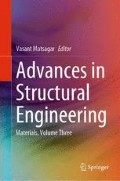Abstract
Concrete is the most widely used construction material because of its mouldability into any required structural form and shape due to its fluid behavior at early ages. Thorough compaction, using vibration, is normally essential for achieving workability , the required strength and durability of concrete. Inadequate compaction of concrete results in large number of voids, affecting strength and long-term durability of structures. Self-compacting concrete (SCC) provides a solution to these problems. As the name signifies, it is able to compact itself without any additional vibration or compactive effort. However, widespread applications of self-compacted concrete have been restricted due to lack of standard mix design procedure and testing methods. Self-compacted concrete is used as a special concrete in place of standard concrete due to lack of mix design procedures. It is gaining wide acceptability because no vibration is needed and noise pollution is eliminated thereby. The construction process is safer and more productive. This paper presents the performance of self-compacted concrete by using ordinary Portland cement, metakaolin (MK) as a mineral admixture and Glenium B233 as a superplasticizer. Metakaolin is produced by heating kaolin, one of the most abundant natural clay minerals, to temperatures of 700–850 °C. The performance of metakaolin in self-compacting concrete is not well documented, particularly over a wide range of grades. In particular, the effects of metakaolin as a high surface area mineral addition on the workability as well as mechanical properties of self-compacting concrete need to be fully recognized. Therefore, the present study is an effort to characterize the fresh and hardened properties of self-compacting concrete containing metakaolin. Glenium B233 is an admixture of a new generation based on modified poly carboxylic ether. It is free from chloride and is compatible with all types of cements. This experimental study demonstrates that metakaolin can be successfully used as an admixture in the preparation of self-compacting concrete (SCC). In order to prepare suitable mix proportions for different grades of metakaolin based self-compacting concrete, investigations were undertaken replacing cement with 0, 10, 15, 20, 25 and 30 % of metakaolin and with different percentages of superplasticizer (Glenium B233). As per the European guidelines for self-compacting concrete, slump flow test, V-funnel test and L-box test have been carried out on fresh properties of metakaolin based self-compacting concrete. The compressive strength , split tensile strength and flexural strength of the specimens have been analyzed for 7 and 28-days curing. In addition, finally mix proportions have been recommended for low, medium and high strength grades of metakaolin based self-compacting concrete . The fresh concrete test results revealed that by substituting different percentages of metakaolin in self-compacting concrete, satisfactory workability and rheological properties could be achieved, even though no viscosity-modifying agent was needed. In general, it seems that metakaolin can be considered as suitable replacement regarding to the economic efficiency, fresh and hardened properties of metakaolin based self-compacting concrete. The test results for acceptance characteristics of self-compacting concrete such as slump flow test, V-funnel test and L-Box test were satisfactory as per EFNARC for developed mix proportions of M60, M40 and M20 grade self-compacting concrete mixes. Further, compressive strength , tensile strength and flexural strength at the ages of 7 and 28 days were also determined and 10–15 % replacement of metakaolin can be regarded as a suitable replacement and mix proportions have been recommended for low (M20), medium (M40) and high (M60) strength grades of metakaolin based self-compacting concrete from this study.
Access this chapter
Tax calculation will be finalised at checkout
Purchases are for personal use only
References
The European guidelines for self-compacting concrete; specification production and use. EFNARC, May 2005
Neville AM (1995) Properties of concrete, 4th edn. Longman, London
Al-Akhras NM (2006) Durability of metakaolin concrete to sulfate attack. Cem Concr Res 36:1727–1734
Sabir BB, Wild S, Khatib JM (1996) On the workability and strength development of metakaolin concrete. In: Dhir RK, Dyer TD (eds) Concrete for environmental enhancement and protection. E&FN Spon, London, pp 651–656
Vejmelkova E, Keppert M, Grzeszczyk S, Skalinski B, Cerny R (2011) Properties of self-compacting concrete mixtures containing metakaolin and blast furnace slag. Constr Build Mater 25:1325–1331
Vejmelkova E, Pavlikova M, Keppert M, Kersner Z, Rovnanikova P, Ondracek M (2010) High performance concrete with Czech metakaolin: experimental analysis of strength, toughness and durability characteristics. Constr Build Mater 24:1404–1411
Author information
Authors and Affiliations
Corresponding author
Editor information
Editors and Affiliations
Rights and permissions
Copyright information
© 2015 Springer India
About this paper
Cite this paper
Ghorpade, V.G., Subash, K.V., Anand Kumar, L.C. (2015). Development of Mix Proportions for Different Grades of Metakaolin Based Self-compacting Concrete. In: Matsagar, V. (eds) Advances in Structural Engineering. Springer, New Delhi. https://doi.org/10.1007/978-81-322-2187-6_132
Download citation
DOI: https://doi.org/10.1007/978-81-322-2187-6_132
Publisher Name: Springer, New Delhi
Print ISBN: 978-81-322-2186-9
Online ISBN: 978-81-322-2187-6
eBook Packages: EngineeringEngineering (R0)

